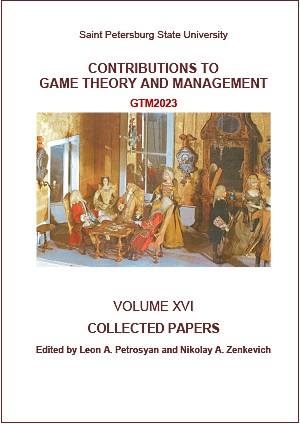Cooperative Solutions for Network Games with Quadratic Utilities
Abstract
This paper analyzes the public goods model with linear quadratic utilities in which each player determines the intensity of the activity they take, which can also be described as a network game with local payoff complementarity, as well as positive payoffs and negative quadratic costs. Players play cooperative games with each other, and cooperative solutions when the game is the planner's optimal concern for the collective, describing each player's optimal action in maximizing the individual and public interest. They are implemented programmatically to facilitate simple computations. In these games, players' activities can be linked to their positions in the local interaction network. The cooperative actions taken by any player are proportional to their Katz-Bonacich centrality in a complementary linear quadratic game. In other words, higher Katz-Bonacich centrality, higher action. We then use a comparative statics framework to analyse the effect that changes in individual variables have on cooperative actions.
Keywords:
network game, quadratic utility function, cooperation, Katz-Bonasic centrality
Downloads
References
Akerlof, G. A. (1997). Social Distance and Social Decisions. Econometrica, 65(5), 1005–1027.
Allouch, N. (2015). On the private provision of public goods on networks. Journal of Economic Theory, 157, 527–552.
Ballester, C., Calvó-Armengol, A., Zenou, Y. (2006). Who's Who in Networks. Wanted: The Key Player. Econometrica, 74(5), 1403–1417.
Bramoullé, Y., Kranton, R. (2007). Public goods in networks. Journal of Economic theory, 135(1) , 478–494.
Belhaj, M., Bramoullé, Y., Deroian, F. (2014). Network games under strategic complementarities. Games and Economic Behavior, 88, 310–319.
Cooper, R., John, A. (1988). Coordinating coordination failures in Keynesian models. The Quarterly Journal of Economics, 103(3), 441–463.
Cvetković, D.M., Rowlinson, P. (1990). The largest eigenvalue of a graph: A survey. Linear Multilinear Algebra,28, 3–33.
Calvó-Armengol, A., Patacchini, E., Zenou, Y. (2009). Peer effects and social networks in education. The review of economic studies, 76(4), 1239–1267.
Debreu, G., Herstein, I. N. (1953). Nonnegative Square Matrices. Econometrica, 21(4), 597–607.
Demange, G. (2017). Optimal targeting strategies in a network under complementarities. Games and Economic Behavior, 105, 84–103.
Economides, N. (1996). The Economics of Networks. International Journal of Industrial Organization, 14, 673–699.
Jackson, M. O. (2008). Social and economic networks (Vol. 3). Princeton: Princeton university press.
Jackson, M. O., Rogers, B. W., Zenou, Y. (2017). The Economic Consequences of Social-Network
Structure. Journal of Economic Literature, 55(1), 49–95.
Kandel, E., Lazear, E. P. (1992). Peer Pressure and Partnerships. Journal of Political Economy, 100(4), 801–817.
Downloads
Published
How to Cite
Issue
Section
License
Articles of "Contributions to Game Theory and Management" are open access distributed under the terms of the License Agreement with Saint Petersburg State University, which permits to the authors unrestricted distribution and self-archiving free of charge.




